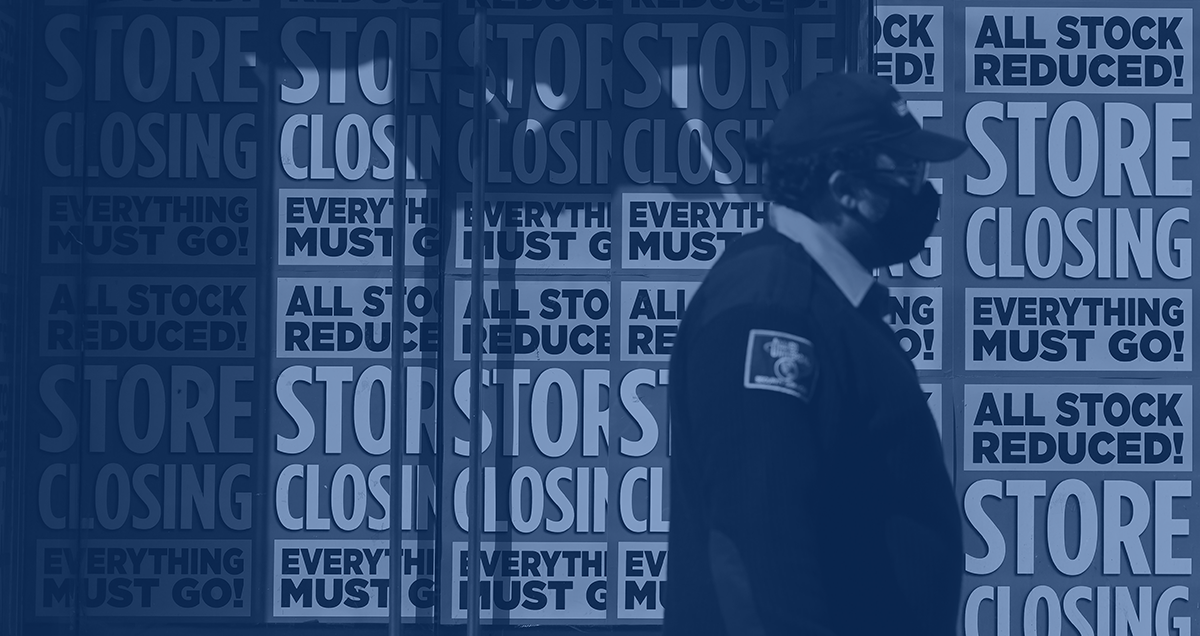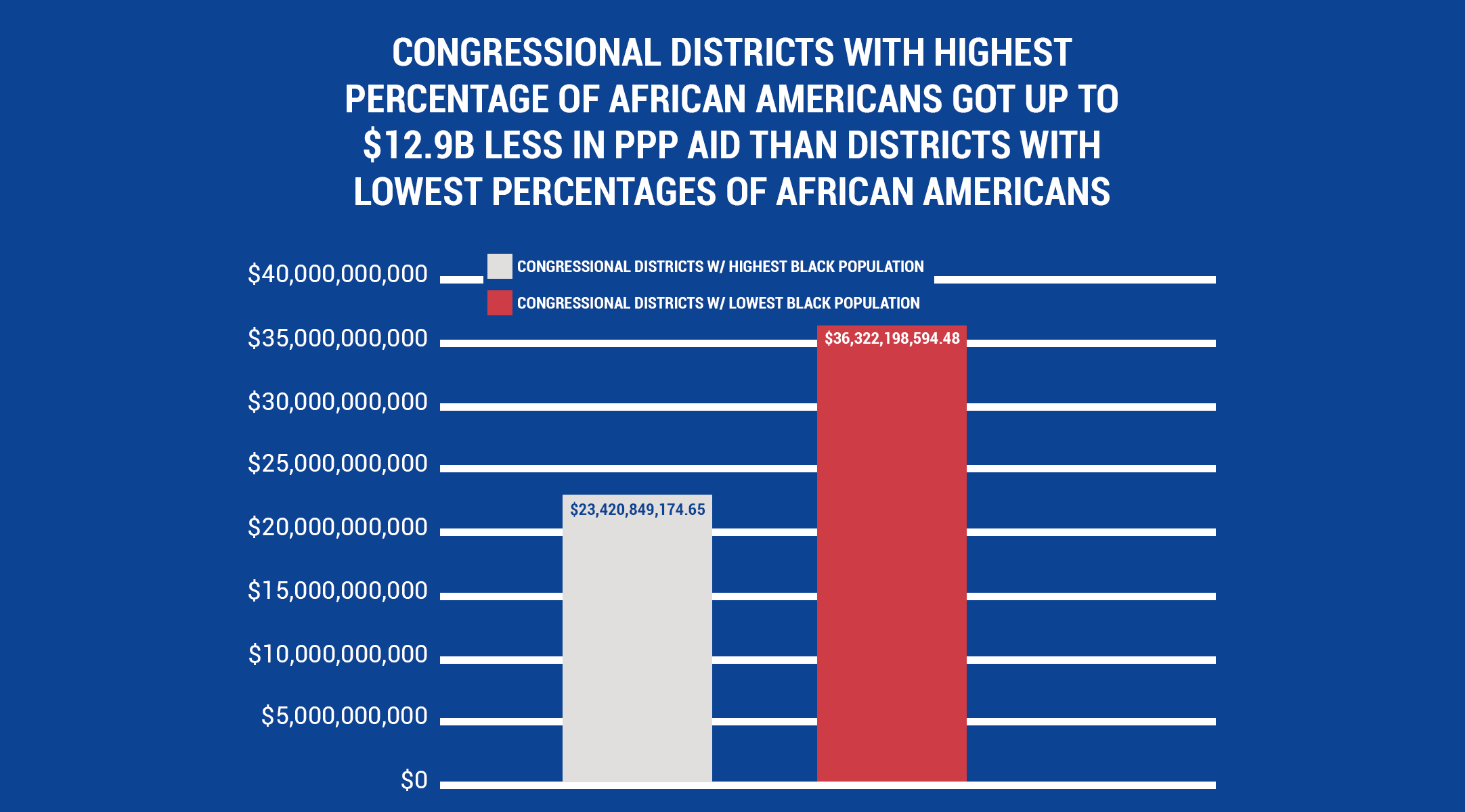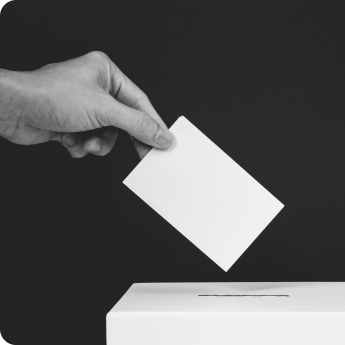Reports
Congressional Districts With Highest Percentage Of Black Residents Shortchanged By Paycheck Protection Program

SUMMARY: The Paycheck Protection Program was introduced amid the COVID-19 pandemic as a lifeline for small businesses. But recent data and reports on the program have shown its failure to sufficiently aid minority-owned businesses. The Center for Responsible Lending estimates that 90-percent “of businesses owned by people of color have been, or will likely be, shut out of the Paycheck Protection Program.’” And overall, only 12-percent of black and Latino business owners have received relief requested from SBA programs, including PPP, after applying.
An original analysis of PPP data by Accountable.US shows that Congressional districts with the highest percentage of black residents received proportionally less aid through the Paycheck Protection Program (PPP). Key findings from the analysis:
- The ten congressional districts with the highest percentage of black residents got up to $12.9 billion less in PPP loan funds than the ten districts with the lowest percentage of black residents, a difference of over 35-percent.
- The ten congressional districts with the highest percentage of black residents received 40-percent fewer total PPP loans than the ten districts with the lowest percentage of black residents, a difference of over 64,000 loans.
- The ten congressional districts with the highest percentage of black residents received hundreds less in PPP loan dollars per capita than the ten districts with the lowest percentage—36-percent less for loans under $150,000 and 22-percent less for loans of $150,000 or more.
The Ten Congressional Districts With The Highest Percentage Of Black Residents Got Up To $12.9 Billion Less In PPP Loan Funds Than The Ten Districts With The Lowest Percentage Of Black Residents, A Difference Of Over 35%.

The 10 Congressional Districts With The Highest Percentage Of Black Or African-American Individuals Received As Much As $23,420,849,174.65 In PPP Loans. [Accountable.US, 07/20/20]
- This Included A Maximum Of $12,380,249,174.65 In PPP Loans Valued At Less Than $150,000. [Accountable.US, 07/20/20]
- This Included A Maximum Of $11,040,600,000.00 In PPP Loans Valued At $150,000 Or More. [Accountable.US, 07/20/20]
The 10 Congressional Districts With The Lowest Percentage Of Black Or African-American Individuals Received As Much As $36,322,198,594.48 In PPP Loans. [Accountable.US, 07/20/20]
- This Included A Maximum Of $21,082,798,594.48 In PPP Loans Valued At Less Than $150,000. [Accountable.US, 07/20/20]
- This Included A Maximum Of $15,239,400,000.00 In PPP Loans Valued At $150,0000 Or More. [Accountable.US, 07/20/20]
PPP Loans To The Top 10 Districts With The Highest Black Populations Accounted For 4.5-Percent Of PPP Funds Approved As Of July 26, 2020, While The Top 10 Least Black Districts Accounted For 7-Percent Of All Loans Approved In That Same Timeframe.
As Of July 26, 2020, The Small Business Administration Approved $519,601,055,582 In PPP Dollars Through 5,009,228 Loans. [U.S. Small Business Administration, accessed 06/27/20]
The 10 Congressional Districts With The Highest Percentage Of Black Or African-American Individuals Received As Much As $23,420,849,174.65 In PPP Loans. [Accountable.US, 07/20/20]
- $23,420,849,174.65 Divided By $519,601,055,582 Equals 4.5% [Query, Google, accessed 07/27/20]
The 10 Congressional Districts With The Lowest Percentage Of Black Or African-American Individuals Received As Much As $36,322,198,594.48 In PPP Loans. [Accountable.US, 07/20/20]
- $36,322,198,594.48 Divided By $519,601,055,582 Equals 6.99% [Query, Google, accessed 07/27/20]
The Ten Congressional Districts With The Highest Percentage Of Black Residents Received 40% Fewer Total PPP Loans Than The Ten Districts With The Lowest Percentage Of Black Residents, A Difference Of Over 64,000 Loans.

There Were 64,482 More PPP Loans In The 10 Congressional Districts With The Lowest Percentage Of Black Residents Than There Were In The 10 Districts With The Highest Percentage—705 More Loans Per 100,000 People.
The 10 Congressional Districts With The Highest Percentage Of Black Or African-American Individuals Received 94,082 PPP Loans. [Accountable.US, 07/20/20]
The 10 Congressional Districts With The Lowest Percentage Of Black Or African-American Individuals Received 158,564 PPP Loans. [Accountable.US, 07/20/20]
There Were 705.07 Fewer PPP Loans Per 100,000 People In The Districts With The Highest Black Populations. [Accountable.US, 07/20/20]
The Ten Congressional Districts With The Highest Percentage Of Black Residents Received Hundreds Less In PPP Loan Dollars Per Capita Than The Ten Districts With The Lowest Percentage—36% Less For Loans Under $150K And 22% Less For Loans Of $150K Or More.

The 10 Congressional Districts With The Highest Percentage Of Black Residents Received $953.41 Less Per Capita For Loans Of Less Than $150,000 Than The Districts With The Lowest Percentage.
Among The 10 Districts With The Highest Percentage Of Black Or African-American Individuals, The Average Per Capita Amount Of PPP Loans Of Less Than $150,000 Was $1,655.46. [Accountable.US, 07/20/20]
Among The 10 Districts With The Lowest Percentage Of Black Or African-American Individuals, The Average Per Capital Amount Of PPP Loans Of Less Than $150,000 Was $2,608.87. [Accountable.US, 07/20/20]
The 10 Congressional Districts With The Highest Percentage Of Black Residents Received $419.50 Less Per Capita For Loans Of $150,000 Or More Than The Districts With The Lowest Percentage.
Among The 10 Districts With The Highest Percentage Of Black Or African-American Individuals, The Average Per Capita Amount Of PPP Loans Of $150,000 Or More Was $1,471.47. [Accountable.US, 07/20/20]
Among The 10 Districts With The Lowest Percentage Of Black Or African-American Individuals, The Average Per Capital Amount Of PPP Loans Of $150,000 Or More Was $1,890.96. [Accountable.US, 07/20/20]
The 10 Districts With The Highest Black Populations Received Just 1.87% Of All PPP Loans Disbursed By July 26, 2020 While The Districts With The Lowest Black Populations Received 3.16% Of All Loans Approved At That Time.
As Of July 26, 2020, The Small Business Administration Approved $519,601,055,582 In PPP Dollars Through 5,009,228 Loans. [U.S. Small Business Administration, accessed 06/27/20]
The 10 Congressional Districts With The Highest Percentage Of Black Or African-American Individuals Received 94,082 PPP Loans. [Accountable.US, 07/20/20]
- 94,082 Divided By 5,009,228 Equals 1.87%. [Query, Google, accessed 07/27/20]
The 10 Congressional Districts With The Lowest Percentage Of Black Or African-American Individuals Received 158,564 PPP Loans. [Accountable.US, 07/20/20]
- 158,564 Divided By 5,009,228 Equals 3.16%. [Query, Google, accessed 07/27/20]
The PPP Has Deeply Neglected Minority-Owned Small Businesses, With Over 90% Of Non-White Small Businesses Reportedly Lacking Access To The Program And Only 12% Of Black- And Latino-Owned Applicants Getting The SBA Relief They Requested.
The PPP Has Faced Criticism For Severely Disadvantaging Minority-Owned Small Businesses, With Over 90% Expected To Have No Access To The Program.
According To The Center For Responsible Lending, Upwards Of 90% Of Businesses Owned By People Of Color Have Been, Or Will Likely Be, Shut Out Of The Paycheck Protection Program. “‘Based on how the program is structured, we estimate that upwards of 90% of businesses owned by people of color have been, or will likely be, shut out of the Paycheck Protection Program,’ said Ashley Harrington, director of federal advocacy and senior council for the Center for Responsible Lending, a non-profit group that combats abusive lending practices and recently examined the loan program’s parameters.” [CBS News, 04/22/20]
“’Roughly 95% Of Black-Owned Businesses, 91% Of Latino-Owned Businesses, 91% Of Native Hawaiian Or Pacific Islander-Owned Businesses, And 75% Of Asian-Owned Businesses Stand Close To No Chance Of Receiving A PPP Loan Through A Mainstream Bank Or Credit Union.’” [CBS News, 04/22/20]
Only 12% Of Black- And Latino-Owned Businesses That Applied For SBA Relief, Including Its Paycheck Protection Program, Have Gotten What They’ve Asked For.
Only 12% Of Black And Latino Business Owners Who Applied For SBA Relief Have Received What They Ask For And 26% Said They “Received Only A Fraction Of What They Had Requested.” “Black and Latino business owners are struggling to get pandemic assistance under the Paycheck Protection Program and other federal aid efforts, a new survey has found, and many say they are on the brink of closing permanently. […] Just 12 percent of the owners who applied for aid from the Small Business Administration — most of them seeking loans in the $650 billion paycheck program — reported receiving what they had asked for, while 26 percent said they had received only a fraction of what they had requested. Nearly half of all owners said they anticipated having to permanently close in the next six months.” [New York Times, 05/18/20]
PPP Was Intended To Offer Forgivable Loans To Small Businesses Struggling With The Coronavirus Pandemic.
The PPP Was Intended To Help Keep Workers Employed During The Pandemic, Offering Forgivable Loans To Employers Who Used The Program’s Loans To Maintain Payroll. “The Paycheck Protection Program was designed to help small business weather the coronavirus pandemic while keeping their workers employed. But government data suggests that hundreds of thousands of businesses across the country got access to funds without indicating how many jobs would be saved. […] The loans distributed through the program were partially or fully forgivable depending on how much of the proceeds were used to keep employees on payroll.” [MarketWatch, 07/11/20]
Detailed Data For PPP Loans Of $150,000 Or More Was Released On July 6, 2020.
July 6, 2020: The Small Business Administration Released Detailed Data On Paycheck Protection Program Loans Of $150,000 Or More. [U.S. Small Business Administration, 07/06/20]
Congressional Districts Considered In This Analysis:


